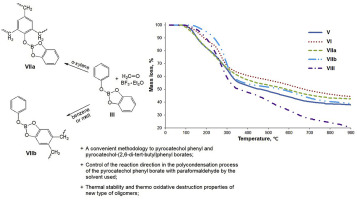The paper of NIOCh's researcher Elvira E.Shul'ts (co-author) is published in the journal Polymer (IF=8,456)
Pyrocatechol borates: Synthesis, reaction with formaldehyde, and solvent effect on polycondensation process
Maxim A.Lenskiy, Elvira E.Shul'ts, Dmitriy V.Korabel'nikov, Andrey V.Ozhogin, Alexey N.NovitskiyPolymer
Volume 188, 3 February 2020, 122162
https://doi.org/10.1016/j.polymer.2020.122162

Abstract
Pyrocatechol (I) and dipyrocatechol (II) borates were synthesized by esterification between pyrocatechol (1,2-dihydroxybenzene) and boric acid in о-xylene with azeotropic distillation of water. The co-esterification between pyrocatechol and boric acid with added equimolar quantities of phenol or 2,6-di-tert-butylphenol was studied, and pyrocatechol phenyl (III) and pyrocatechol-(2,6-di-tert-butyl)phenyl (IV) borates were prepared. The reaction of the resultant esters with formaldehyde in the presence of boron trifluoride etherate as a catalyst was examined. The coupling of the methylene moiety in several position of moleculeIII was found to be dependent on the solvent used. The electrophilic substitution on the phenol substituent took place in о-xylene, while the reaction in either benzene or molten monomer proceeded to substitute the methylene moiety for the proton on the catechol moiety. The molecular weights of the compounds were measured. Some properties of the synthesized oligomers were determined and thermal and thermooxidative destruction was examined.
Altmetrics:


